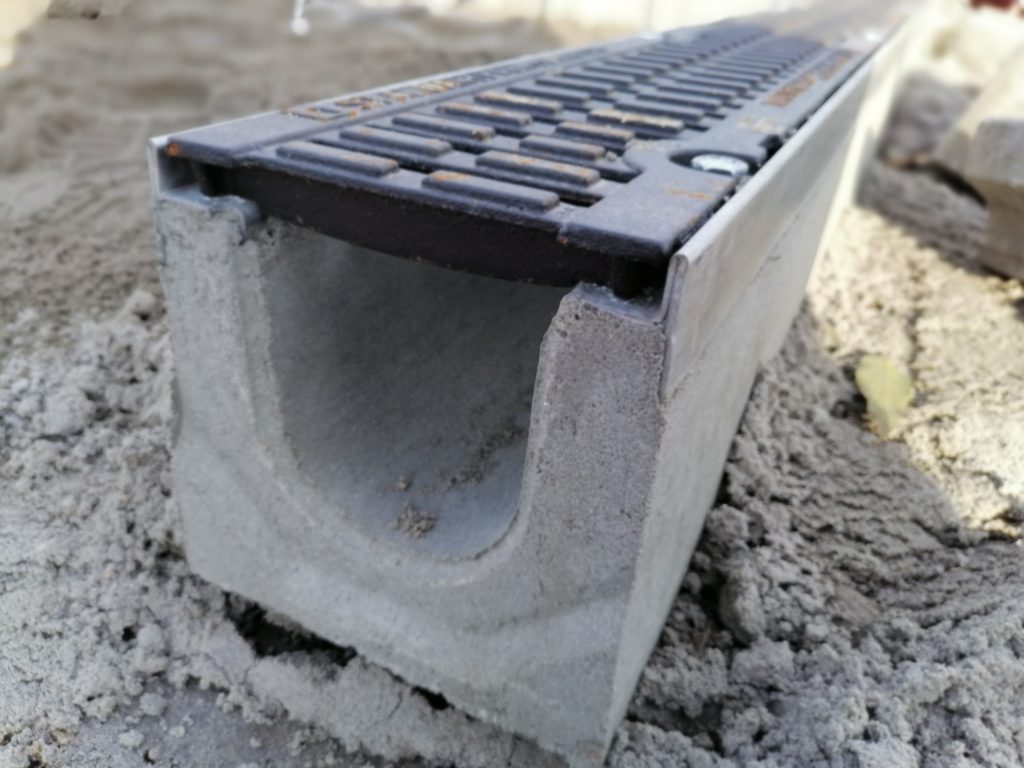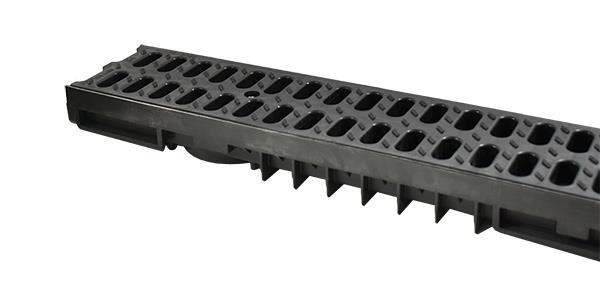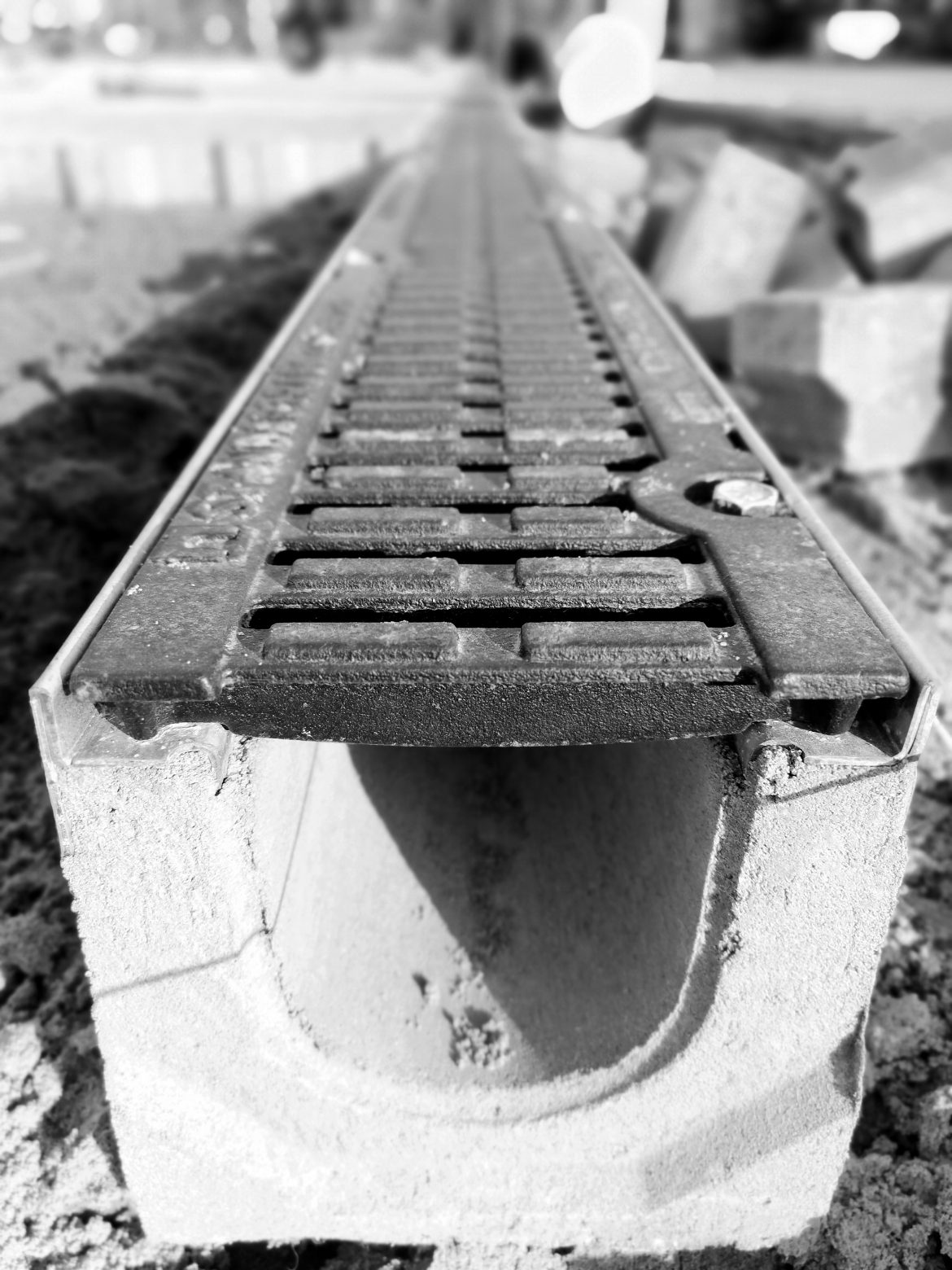Aby zapobiegać zalaniu posesji przez wodę deszczową i związanymi z nim szkodom materialnym, należy zaplanować odprowadzanie wody deszczowej przez odwodnienie liniowe. Dotyczy to każdej posesji, zwłaszcza z dużym polem powierzchni nieprzepuszczalnej (beton, kostka brukowa). W przypadku powierzchni płaskich takich jak chodniki i podjazdy najczęściej stosuje się odwodnienia liniowe.
Odwodnienie liniowe posesji – sposób działania
Odwodnienie liniowe zewnętrzne najczęściej składa się z kanału i zabezpieczającego go rusztu. Jego podstawowe zadanie polega na przechwytywaniu wody deszczowej i odprowadzaniu jej do kanalizacji, zbiorników podziemnych, rowów melioracyjnych, studni chłonnych czy układów drenarskich. Przy lokalizowaniu kanałów odwodnienia liniowego należy uwzględnić rzeźbę terenu. Odwodnienia liniowe najlepiej będą sprawdzały się w zagłębieniach terenu, odprowadzając spływającą do nich wodę i zapobiegając jej zaleganiu.
Korytka mogą być wykonane z: [su_list icon=”icon: search-plus” icon_color=”#2aa3d1″]
- polimerbetonu (mieszanki żywicy, ziarnistego kwarcu i betonu) – zapewniającego trwałość, odporność na substancje chemiczne i niską temperaturę,
- betonu – takie korytka są znacznie cięższe od polimerobetonowych, ale również bardziej wytrzymałe na nacisk, np. korytko betonowe Betomax z rusztem D400,
- tworzyw sztucznych (PE, PP, PVC), np. korytko ruszt PP A15 – zapewniających niską masę łatwy transport i nieskomplikowany montaż.[/su_list]
Korytka łączymy ze sobą przy zachowaniu odpowiedniego spadku, dzięki czemu odprowadzana deszczówka spływa grawitacyjnie w pożądanym kierunku.
Jak wybrać odwodnienie liniowe
Przy wyborze systemu odwodnienia liniowego należy wziąć pod uwagę kilka kryteriów doboru:
1. Klasa wytrzymałości systemu odwodnienia liniowego
Najważniejszym kryterium technicznym, od którego należy rozpocząć proces doboru korytka jest jego klasa wytrzymałości. Klasa wytrzymałości to ustalony normami wskaźnik określający wytrzymałość danego materiału na nacisk statyczny, z którego wynikają dopuszczalne zastosowania produktów.
Oferujemy systemy korytek odwodnienia liniowego w następujących klasach wytrzymałości:
[su_list icon=”icon: search-plus” icon_color=”#2aa3d1″]
- Klasa A15 – jest to najniższa klasa wytrzymałości w skali. Produkty klasy A15 są bezpieczne do stosowania w drogach i chodnikach na których odbywa się ruch pieszy i rowerowy. UWAGA: Klasa A15 nie obejmuje ruchu pojazdów. Przy zastosowaniu produktów klasy A15 w miejscach na których odbywa się ruch samochodów osobowych takich jak garaże, podjazdy i parkingi ryzykuje się zniszczenie produktu i utratę gwarancji producenta.
- Klasa B125 – to produkty do zabudowy indywidualnej np. w garażach, ogrodach, parkach.
- Klasa C250 – obejmuje produkty przeznaczone pod ruch pojazdów osobowych o niewielkim natężeniu. Produkty z tej klasy idealnie nadają się do zastosowania na podjazdach, parkingach i w garażach.
- Klasa D400 – produkty przeznaczone są do użytku w ciągach drogowych o dużym natężeniu ruchu, na parkingach czy placach manewrowych na których odbywa się ruch ciężarowy.[/su_list]

Korytko betonowe – najbardziej wytrzymałe
2. Wysokość koryt odwodnienia liniowego
Wysokość koryta w systemie odwodnienia liniowego ma wpływ na dwa czynniki: przepustowość kanału oraz sposób jego montażu. W większości przypadków wysokość kanału łączy się bezpośrednio z jego przepustowością i im głębszy będzie kanał, tym wyższa maksymalna przepustowość. Jednak w pewnych sytuacjach, zwłaszcza w pracach wykonywanych na istniejących parkingach i podjazdach nie zawsze można zamontować kanał o standardowej wysokości. Jeżeli wstawienie kanału wiąże się z wykuciem bruzdy, w której ma zostać zamontowany w betonie lub asfalcie, albo jeśli niemożliwe jest wykonanie wykopu na wymaganą głębokość, stosuje się korytka spłaszczone (np. Odwodnienie liniowe korytko z rusztem PP A15 1000x130x55 mm ). Korytka takie pozwalają na zamontowanie układu odwodnienia liniowego nawet jeśli dostępna głębokość montażu jest niewielka.
3. Estetyka i materiał wykonania rusztów
Ponieważ ruszty koryt odwodnienia liniowego są widoczne na powierzchni chodników czy podjazdów należy wziąć pod uwagę ich kolor i materiał wykonania. Najwytrzymalsze z oferowanych przez nas koryt mają ruszty z żeliwa, ale w przypadku koryt klasy A15 istnieje wybór między rusztami ze stali ocynkowanej, a czarnymi rusztami z polipropylenu. Wszystkie ruszty, które oferujemy są zabezpieczone przez korozją. Dodatkową zaletą rusztów z tworzywa sztucznego jest odporność na substancje chemiczne, które mogą niszczyć ruszty metalowe.

Przykład korytka z czarnego PP
Połączenie odwodnienia liniowego z odbiornikiem wody deszczowej
Aby układ odwodnienia liniowego działał popranie, musi być połączony z odbiornikiem wody deszczowej.
Funkcję odbiornika mogą pełnić:
[su_list icon=”icon: search-plus” icon_color=”#2aa3d1″]
- Tereny zielone poniżej powierzchni, w której zamontowano odwodnienie liniowe
- Układy kanalizacji deszczowej i ogólnospławnej
- Układy rozsączające i drenarskie[/su_list]
Woda możemy odprowadzać z koryt odwodnienia liniowego za pomocą:
[su_list icon=”icon: search-plus” icon_color=”#2aa3d1″]
- Króćca bocznego – (lub zakończenia kanału z króćcem). W przypadku odejść bocznych mamy do dyspozycji króćce boczne lub króćce stanowiące element zakończenia kanału. Zazwyczaj króćce wymagają otwarcia otwornicą lub innym narzędziem. Wykonuje się to przed połączeniem go z rurami kanalizacyjnym prowadzącymi do odbiornika.
- Króćca dolnego – Każde korytko ma również możliwość odprowadzenia wody deszczowej w dół. W niektórych przypadkach konieczne jest dokupienie dodatkowych elementów, aby odprowadzić wodę deszczową w tym kierunku. W przypadku koryt betonowych trzeba wybrać specjalne koryta wyposażone w odejście. Wybierając koryta plastikowe konieczne może być dokupienie króćców montażowych pozwalających na przyłączenie rury kanalizacyjnej do dna koryta.
- Ze studzienki podwórzowej – Inną możliwością jest wykorzystanie studzienki podwórzowej. Studzienki podwórzowe można połączyć z systemem odwodnienia liniowego jako element pośredni połączenia z odbiornikiem wody deszczowej. Studzienka podwórzowa wymaga montażu na większej głębokości niż korytka, jednak jej zastosowanie zapewnia dodatkowe zalety. Studzienka zapewnia dodatkową objętość układu na przechwycenie nawalnego deszczu, a ponadto pomaga w oczyszczeniu wody deszczowej spływającej do odbiornika.[/su_list]
[su_box title=”Uwaga!” box_color=”#919185″ title_color=”#141413″ radius=”2″]W przypadku układów odwodnienia liniowego podłączonych do kanalizacji ogólnospławnej należy pamiętać o konieczności zastosowania syfonu, którego funkcją jest zatrzymywanie odorów z kanalizacji. Jeżeli do systemu odwodnienia liniowego producent nie oferuje szczelnego syfonu jako akcesorium koryt lub studzienek, należy zakupić gotowy syfon z innego źródła lub wykonać prosty syfon gwarantujący szczelne zamknięcie wodne z kolanek kanalizacyjnych.[/su_box]
Odwodnienie liniowe może być uzupełnione wycieraczkami (w formie skrzynki przykrytej rusztem i połączonej z rurą odprowadzającą) albo wpustem podwórzowym, umieszczonym na końcu kanału, pod rynną lub kranem ogrodowym.
